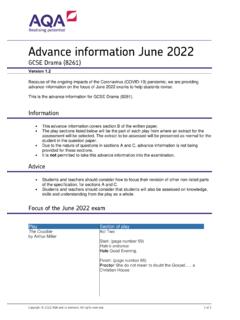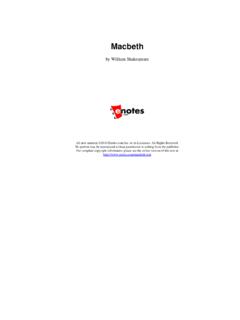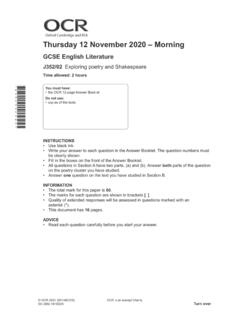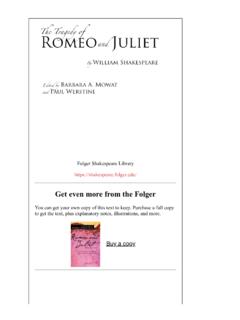Transcription of Romeo and Juliet (SparkNotes) - ESL EXTRA
1 Romeo AND JULIETW illiam ShakespeareContributors: Brian Phillips, Brian Gatten, Julie BlattbergNote: This SparkNote uses The Norton shakespeare edition of Romeo and Juliet . Some line and scene numbers may vary in other 2002 by SparkNotes LLC All rights reserved. No part of this book may be used or reproduced inany manner whatsoever without the written permission of the is a registered trademark of SparkNotes edition published by Spark PublishingSpark PublishingA Division of SparkNotes LLC76 9th Avenue, 11th FloorNew York, NY 10011 ISBN 1-4014-0435-9 Text design by Rhea BraunsteinText composition by Jackson TypesettingPrinted and bound in the United States of America01 02 03 04 05 SN 9 8 7 6 5 4 3 2 PROLOGUE FROM THE BARDB rave scholars, blessed with time and energy, At school, fair Harvard, set about to glean,From dusty tomes and modern poetry.
2 All truths and knowledge formerly forth the hungry minds of these good folk Study guides, star-floss d, soon came to life;Whose deep and deft analysis awoke The latent A s of those in lit rary far past passing insight from our trove Will free your comprehension from its SparkNotes worth, online we also prove; Behold this book! Same brains, but paper patient or whatever, please attend, What you have missed, our toil shall strive to 1 PLOT OVERVIEW 4 CHARACTER LIST 8 ANALYSIS OF MAJOR CHARACTERS 11 Romeo 11 Juliet 12 Friar Laurence 13 Mercutio
3 14 THEMES, MOTIFS, AND SYMBOLS 15 Love 15 The Relationship between Love and Death, Passion, and Violence 16 The Conflict between Social Institutions and the Inner Self 17 Fate 18 Light/Dark Imager y 19 Alternative Views of Events in the Play 19 SUMMARY AND ANALYSIS 21 Prologue 21 Act I.
4 Scenes i-v 22 Act II, Prologue-scene v 34 Act III, scenes i-v 41 Act IV, scenes i-iv 49 Act V, scenes i-iii 53 IMPORTANT QUOTATIONS EXPLAINED 59 KEY FACTS 62 STUDY QUESTIONS AND ESSAY TOPICS 64 REVIEW AND RESOURCES 67 Quiz 67 Suggestions for Further Reading 72vi ContentsCONTEXT Likely the most influential writer in all of English literature and certainly the most important
5 Playwright of the English Renais-sance, William shakespeare was born in 1564 in the town of Stratford-upon-Avon in Warwickshire, England. The son of a successful middle-class glove-maker, shakespeare attended grammar school, but his formal education proceeded no further. In 1582, he married an older woman, Anne Hathaway, and had three children with her. Around 1590, he left his family behind and traveled to London to work as an actor and playwright. Public and critical acclaim quickly followed, and Shake-speare eventually became the most popular playwright in England and part owner of the Globe Theater. His career bridged the reigns of Eliza-beth I (ruled 1558 1603) and James I (ruled 1603 1625); he was a favor-ite of both monarchs.
6 Indeed, King James paid shakespeare s theater company the greatest possible compliment by endowing its members with the status of king s players. Wealthy and renowned, shakespeare retired to Stratford, and died in 1616 at the age of fifty-two. At the time of shakespeare s death, such luminaries as Ben Jonson hailed him as the apogee of Renaissance s works were collected and printed in various editions in the century following his death, and by the early eighteenth century his reputation as the greatest poet ever to write in English was well established. The unprecedented admiration garnered by his works led to a fierce curiosity about shakespeare s life, but the dearth of biographi-cal information has left many details of shakespeare s personal history shrouded in mystery.
7 Some scholars have concluded from this lack and from shakespeare s modest education that his plays were actually writ-ten by someone else Francis Bacon and the Earl of Oxford are the two most popular candidates. The evidence for this claim, however, is over-whelmingly circumstantial, and few take the theory very the absence of evidence to the contrary, shakespeare must be viewed as the author of the thirty-seven plays and 154 sonnets that bear his name. The legacy of this body of work is immense. A number of shakespeare s plays seem to have transcended even the category of brilliance, becoming so influential as to affect profoundly the course of Western literature and culture ever in the mid-1590s and first published in 1597, Romeo and Juliet is shakespeare s first nonhistorical tragedy, and it is in many ways the richest and most mature of his early works.
8 The writing bears many of the characteristics of shakespeare s early work, with frequent use of end-rhymes and an abundance of descriptive, metaphoric did not invent the story of Romeo and Juliet . He did not, in fact, even introduce the story into the English language. The generally, and understandably, forgotten Arthur Brooks first brought the story of Romeus and Juliet to an English-speaking audience in a long and plodding poem that was itself not original, but rather an adaptation of adaptations that stretched across nearly a hundred years and two lan-guages. Many of the details of shakespeare s plot are lifted directly from Brooks s poem, including the meeting of Romeo and Juliet at the ball, their secret marriage, Romeo s fight with Tybalt, the sleeping potion, and the timing of the lovers eventual suicides.
9 Such appropriation of other stories is characteristic of shakespeare , who often wrote plays based on earlier works. Two examples are Richard III, which shakespeare based in large part on Thomas More s excellent history of that English king, and Hamlet, which is based on two known sources: one from France, another from medieval Denmark. shakespeare s use of existing mate-rial as fodder for his plays should not be taken as a lack of originality. Instead, readers should note how shakespeare crafts his sources in new ways while displaying a remarkable understanding of the literary tradi-tion in which he is working.
10 shakespeare s version of Romeo and Juliet is no exception. The play distinguishes itself from its predecessors in several important aspects: the subtlety and originality of its character-ization ( shakespeare almost wholly created Mercutio); the intense pace of its action, which is compressed from nine months into four frenetic days; a powerful enrichment of the story s thematic aspects; and, above all, an extraordinary use of readers often view shakespeare as having invented literature, and thus see shakespeare as having occupied an enviable position in which he could create his masterpieces upon a blank and impressionable slate.






